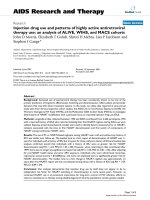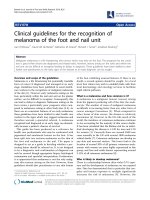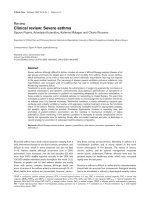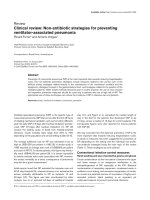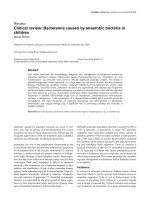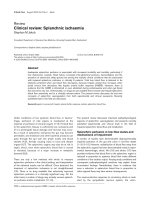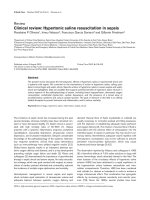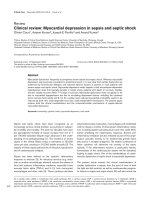Báo cáo y học: " Clinical review: Timing and dose of continuous renal replacement therapy in acute kidney injury" ppsx
Bạn đang xem bản rút gọn của tài liệu. Xem và tải ngay bản đầy đủ của tài liệu tại đây (63.82 KB, 6 trang )
Page 1 of 6
(page number not for citation purposes)
Available online />Abstract
The optimal management of renal replacement therapy (RRT) in
acute kidney injury (AKI) remains uncertain. Although it is well
accepted that initiation of RRT in patients with progressive
azotemia prior to the development of overt uremic manifestations is
associated with improved survival, whether there is benefit to even
earlier initiation of therapy is uncertain. Although retrospective and
observational studies have suggested improved survival with very
early initiation of continuous RRT (CRRT), interpretation of these
studies is confounded by their failure to include patients with AKI
who recover renal function or die without ever receiving RRT.
Several studies have suggested that more intensive delivery of
CRRT during AKI is associated with improved survival, although
results of trials have been inconsistent. Two large multicenter
randomized clinical trials addressing this question are currently
underway and should provide more definitive data within the next
two years.
Introduction
The optimal management of renal replacement therapy (RRT)
in acute kidney injury (AKI) is uncertain. Although supportive
care with RRT has been the mainstay of treatment of severe
AKI for more than five decades, many fundamental aspects of
RRT management remain controversial, including selection of
modality, timing of initiation, and dosing of therapy. In the
past, the commonly held view was that patients with
advanced renal dysfunction died with, but, so long as acute
uremic complications were prevented, did not die of, their
renal failure. The corollary of this view was that management
of RRT merely needed to assure that patients did not
succumb to hyperkalemia, metabolic acidosis, or volume
overload and that overt uremic complications, such as
pericarditis and encephalopathy, were prevented. However,
studies over the past decade have challenged this paradigm,
demonstrating that AKI is an independent risk factor for
mortality [1-5]. An implication of these data is that the
management of RRT may have a critical impact on the
outcomes of AKI and that optimization of renal support may
reduce its high mortality [6-8]. Recent studies have
suggested that more intensive dosing of both continuous
[9,10] and intermittent [11] RRT are associated with
reductions in mortality; however, results have not been
consistent across all studies [12] and these findings have not
been widely applied in clinical practice [13]. Although this
review focuses on the issue of timing and dose of continuous
RRT (CRRT), summarizing recent data and suggesting
avenues for future research, it should be recognized that
many of the same issues apply to the management of
intermittent hemodialysis in AKI. The related issue of modality
of renal support, the subject of multiple recent studies
[14-17], is beyond the scope of this review, and has been
reviewed and debated elsewhere [18-22].
Timing of initiation of continuous renal
replacement therapy
Although the focus of this review is on CRRT, a brief
summary of data regarding the initiation of intermittent hemo-
dialysis in AKI is informative. The concept of prophylactic
hemodialysis in AKI was introduced by Teschan and
colleagues more than 50 years ago [23,24]. A series of retro-
spective case series and observational studies conducted
from the 1950s through the early 1970s compared ‘early’
initiation of hemodialysis, as defined by blood urea nitrogen
(BUN) concentrations ranging from < 93 mg/dl to levels of
approximately 150 mg/dl, to ‘late’ initiation of therapy, as
defined by BUN levels of 163 mg/dl to > 200 mg/dl [25-27].
These studies (Table 1) all demonstrated improved survival
with earlier initiation of hemodialysis. Two prospective clinical
trials comparing early to late initiation of hemodialysis in AKI
were conducted during the 1970s and 1980s [28,29]. In the
first of these prospective trials, 18 patients with post-
traumatic AKI were alternately assigned to an intensive
dialysis regimen to maintain the pre-dialysis BUN at
Review
Clinical review: Timing and dose of continuous renal
replacement therapy in acute kidney injury
Paul M Palevsky
Renal Section, VA Pittsburgh Healthcare System, Pittsburgh, PA 15240, and Renal-Electrolyte Division, Department of Medicine, University of
Pittsburgh School of Medicine, Pittsburgh, PA 15261, USA
Corresponding author: Paul M Palevsky,
Published: 6 November 2007 Critical Care 2007, 11:232 (doi:10.1186/cc6121)
This article is online at />© 2007 BioMed Central Ltd.
AKI = acute kidney injury; BUN = blood urea nitrogen; CRRT = continuous RRT; CVVH = continuous venovenous hemofiltration; CVVHDF = con-
tinuous venovenous hemodiafiltration; ICU = intensive care unit; IHD = intermittent hemodialysis; RRT = renal replacement therapy.
Page 2 of 6
(page number not for citation purposes)
Critical Care Vol 11 No 6 Palevsky
< 70 mg/dl and the serum creatinine at < 5 mg/dl, or to a non-
intensive regimen in which dialysis was not provided until the
BUN approached 150 mg/dl, the creatinine reached 10 mg/dl,
or clinical indications for dialysis were present [28]. Survival
was 64% (5 of 8 patients) in the intensive treatment group
compared to 20% (2 of 10 patients) with the non-intensive
dialysis strategy (p < 0.10 but > 0.05). In addition, major
complications, including hemorrhage and Gram-negative
sepsis were less frequent in the intensive hemodialysis arm.
The second of these two prospective studies entailed 34
patients who were stratified based on the etiology of AKI and
randomized in a paired fashion [29]. Patients were enrolled
when the serum creatinine reached approximately 8 mg/dl
and were dialyzed to maintain a predialysis BUN of
< 60 mg/dl in the intensive treatment arm and approximately
100 mg/dl in the non-intensive arm. The average time to
initiation of dialysis was 5 ± 2 days in the intensive arm and
7 ± 3 days in the non-intensive arm. Mortality was higher in
the less intensively dialyzed group; however, given the small
sample size, this difference was not statistically significant.
On the basis of these data, conventional teaching has been
that in the absence of specific symptoms, hemodialysis should
be initiated when the BUN reaches a level of approximately
100 mg/dl, but that no additional benefit is associated with
earlier initiation of therapy. It should be recognized, however,
that the study on which this argument is based had
inadequate statistical power to draw definitive conclusions. It
has also been argued that a strategy of early initiation of
dialysis might subject patients to the risks of hemodialysis who
would recover renal function with conservative therapy alone
and that exposure to hemodialysis might delay recovery of
renal function and adversely impact patient survival [30].
Several studies over the past decade have evaluated the
impact of timing of initiation of CRRT on outcomes of AKI. In
the first of these studies, Gettings and colleagues [31]
retrospectively analyzed the timing of initiation of continuous
venovenous hemofiltration (CVVH) on outcomes in patients
with post-traumatic AKI by stratifying 100 consecutive
patients based on the BUN at initiation of treatment. ‘Early’
and ‘late’ initiation of therapy were defined by stratifying
patients using the BUN at initiation of therapy, using a value
of 60 mg/dl to separate the two groups. In the ‘early’ group,
CVVH was initiated on hospital day 10 ± 15, with a mean
BUN of 43 ± 13 mg/dl compared to the ‘late’ group, in whom
treatment was initiated after 19 ± 27 days with a mean BUN
of 94 ± 28 mg/dl. Survival was 39% in the ‘early’ initiation
group, compared to 20% in the ‘late’ group (p = 0.041).
Although baseline demographic characteristics and severity
of illness scores of patients in the two groups were
comparable, a greater percentage of patients in the late
cohort had multisystem organ failure or sepsis. In addition,
details of why RRT was initiated earlier as opposed to later
were not provided and may have contributed to unrecognized
differences between the two cohorts.
Table 1
Summary of studies evaluating the timing of initiation of renal replacement therapy
BUN at initiation of RRT (mg/dl) Survival (%)
Study Year Mode of RRT Study design N Early Late Early Late
Parsons et al. [25] 1961 IHD Retrospective 33 120-150 >200 75 12
Fisher et al. [26] 1966 IHD Retrospective 162 ~150 >200 43 26
Kleinknecht et al. [27] 1972 IHD Retrospective 500 <93 >163 73 58
Conger [28] 1975 IHD RCT 18 <70 ~150 64 20
Gillum et al. [29] 1986 IHD RCT 34 <60 ~100 41 53
Gettings et al. [31] 1999 CRRT Retrospective 100 <60 >60 39 20
Bouman et al. [12] 2002 CRRT RCT 106 LV: 48 (40-66)
a
LV: 105 (62-116)
a
LV: 69 LV: 75
HV: 46 (38-58)
a
HV: 74
Demirkiliç et al. [32] 2004 CRRT Retrospective
b
61 NS NS 77 45
Elahi et al. [33] 2004 CRRT Retrospective
b
64 67 ± 35
c
75 ± 61
c
78 57
Piccinni et al. [34] 2006 CRRT Retrospective
d
80 NS NS 55 28
Liu et al. [35] 2006 IHD and CRRT Observational 243 ≤ 76 >76 65 59
a
Median blood urea nitrogen (BUN; quartiles).
b
RRT started based on urine output <100 ml over 8 hours in early group and based on biochemical
parameters in late group.
c
Mean BUN ± standard deviation.
d
Patients with sepsis and oliguria; RRT started within 12 hours of ICU admission in
early group and based on ‘conventional indications’. CRRT, continuous renal replacement therapy; HV, high-volume hemofiltration; IHD, intermittent
hemodialysis; LV, low-volume hemofiltration; NS, not specified; RCT, randomized controlled trial; RRT, renal replacement therapy.
Page 3 of 6
(page number not for citation purposes)
Similar results have been reported in two retrospective
analyses of timing of CRRT in patients following cardiac
surgery [32,33]. Demirkiliç and colleagues [32] reported on a
series of 61 patients undergoing cardiac surgery at a single
center in Turkey between March 1992 and September 2001
who received postoperative continuous venovenous hemo-
diafiltration (CVVHDF). In the 27 patients treated before June
1996, CVVHDF was started when the serum creatinine level
exceeded 5 mg/dl or the serum potassium level exceeded
5.5 mEq/l despite medical therapy, independent of urine
output (group 1); in the remaining 34 patients treated after
June 1996, CVVHDF was initiated if the urine volume was
less than 100 ml over 8 hours despite administration of
furosemide (group 2). Treatment was initiated 2.6 ± 1.7 days
after surgery in group 1 compared to 0.9 ± 0.3 days in group
2. Early initiation was associated with lower ICU (17.6%
versus 48.1%; p < 0.05) and hospital mortality (23.5% versus
55.5%; p < 0.05) and decreased duration of both mechanical
ventilation and ICU length of stay. Similarly, Elahi and
colleagues [33] identified 64 consecutive patients who
underwent cardiac surgery between January 2002 and
January 2003 in a single center in the United Kingdom and
who were treated with post-operative CVVH. In 28 patients,
CVVH was not initiated until the BUN was at least 84 mg/dl,
the creatinine was at least 2.8 mg/dl or the serum potassium
was greater than 6 mEq/l despite medical therapy, regardless
of urine output (group 1), while in the remaining 36 patients
CVVH was initiated if the urine volume was less than 100 ml
over 8 hours despite furosemide infusion (group 2). As in the
prior study, the reported demographic and baseline clinical
characteristics of the two groups were similar. The interval
between surgery and initiation of renal support was 2.6 ± 2.2
days in group 1 compared to 0.8 ± 0.2 days in group 2.
Hospital mortality was 43% in group 1 and 22% in group 2
(p < 0.05). Similar results have been reported by Piccinni and
colleagues [34] in an analysis of 40 consecutive oliguric
patients with sepsis treated with early isovolemic hemo-
filtration compared to 40 consecutive historical controls.
Twenty-eight day survival in the patients treated with
isovolemic hemofiltration was 55% compared to 27.5% in the
historical control cohort.
In another retrospective analysis, Liu and colleagues [35]
analyzed data on the timing of initiation of renal replacement
therapy (both intermittent hemodialysis (IHD) and CRRT)
from the Program to Improve Care in Acute Renal Disease
(PICARD), a multicenter observational study of AKI. The 243
patients in the database who received RRT were stratified
into ‘early’ and ‘late’ initiation groups based on the median
BUN (76 mg/dl) at initiation of therapy. Although patients in
the ‘late’ (BUN > 76 mg/dl) group had a reduced burden of
organ failure, the survival rates at 14 days and 28 days in this
group (0.75 and 0.59, respectively) were slightly lower than
in the ‘early’ (BUN ≤ 76 mg/dl) group (0.8 and 0.65,
respectively). After adjustment for age and clinical factors and
stratification by site and initial modality of RRT in a multi-
variate analysis, the relative risk of death associated with
dialysis initiation with a higher degree of azotemia (using the
‘early’ initiation group as the comparator) was 1.85 (95%
confidence interval 1.16 to 2.96). Similarly, using a
propensity score analysis to adjust for factors predicting
initiation of therapy at a higher compared to a lower BUN, the
relative risk in the high BUN group was 2.07 (95%
confidence interval 1.30 to 3.29). Combining the multivariate
adjustment and the propensity score yielded an adjusted
relative risk of 1.97 (95% confidence interval 1.21 to 3.20).
There are several important limitations to all of these
retrospective studies. First, in the studies by Gettings and
colleagues [31] and Liu and colleagues [35], BUN was used
as a surrogate measure for duration of AKI. However, BUN is
an imperfect surrogate for time. Urea generation is not
constant between patients, or even within an individual
patient over time, and the volume of distribution of urea may
change over time. As a result, the rate of increase in BUN
varies between patients, and may not even be constant in an
individual patient over time. Second is the issue of bias by
indication. Renal support was initiated for oliguria in the ‘early’
groups and for azotemia or hyperkalemia in the ‘late’ groups
in both of the post-cardiac surgery studies [32,33]. Although
the reasons for ‘early’ and ‘late’ initiation of treatment in the
studies by Gettings and colleagues [31] and Liu and
colleagues [35] were not specified, it is likely earlier initiation
was prompted by volume overload and electrolyte
disturbances whereas late initiation of therapy was more likely
to be prompted by progressive azotemia. Whether there is a
relationship between indication for therapy and outcome is
not known. Most importantly, the design of all four of these
studies limited analysis to patients who received renal
replacement therapy, ignoring the subset of patients with AKI
who recover or die without RRT.
A single study has attempted to address the timing of CRRT
prospectively. Bouman and colleagues [12] randomized 106
critically ill patients with AKI at two centers to three groups:
early high-volume CVVH (n = 35), early low-volume CVVH
(n = 35) and late low-volume CVVH (n = 36). Treatment was
initiated in the two early groups within 12 hours of meeting
study inclusion criteria, which included the presence of
oliguria for more than 6 hours despite hemodynamic optimiza-
tion or a measured creatinine clearance of less than
20 ml/minute on a 3 hour timed urine collection. In the late
group, renal support was not initiated until the BUN was more
than 112 mg/dl, potassium was more than 6.5 mEq/l, or
pulmonary edema was present. No significant differences in
survival were observed between the three groups. Of note,
however, the overall 28 day mortality for subjects in this study
was only 27%, substantially lower than mortality rates
reported in most other studies of critically ill patients with AKI,
suggesting a lower disease burden in this cohort. In addition,
as a result of the small sample size, the statistical power of
the study was low, meaning that there is a high likelihood of
Available online />type II error. It is also important to note that 6 of the 36
patients (16.7%) in the late therapy group never received
RRT, 2 patients because they died prior to meeting criteria
for RRT and 4 patients because they recovered renal
function.
Thus, current data remain inadequate to answer the question
of appropriate indications and timing of initiation of CRRT in
AKI. The vast majority of patients with AKI are never treated
with RRT, yet have increased mortality rates [36]. Whether
earlier initiation of RRT, regardless of modality, or provision of
therapy in patients currently managed conservatively,
improves survival remains an open question. Would this
strategy improve outcomes, or does the observational data
suggesting improved outcomes merely reflect inclusion of
patients with a lesser degree of organ injury, whose out-
comes would be better regardless of treatment strategy?
Ultimately, the answer will require data from a prospective
randomized trial. However, the design of such a trial poses
significant challenges; most critically, the need for early
identification of patients who will have persistent and severe
renal injury. Without reliable markers to identify this
population, a substantial number of patients who would not
otherwise be started on RRT will need to be randomized into
an early therapy arm and subjected to the risks of RRT. Thus,
robust biomarkers and/or clinical predictors of the course of
AKI are needed before such a study can be undertaken.
Dose of continuous renal replacement therapy
Three randomized controlled trials have assessed the
relationship between dose of CRRT and outcomes of AKI
(Table 2) [9,10,12]. Since the clearance of low molecular
weight solutes during CRRT closely approximates total
effluent flow, the dose of therapy can be quantified in terms of
the sum of the ultrafiltrate and dialysate flow rates. Ronco and
colleagues [9] randomized 425 critically ill patients with AKI
treated using CVVH at a single center to ultrafiltration rates of
20, 35 or 45 ml/kg/h. Survival 15 days after discontinuation
of CRRT was 41% in the lowest dose arm compared to 57%
and 58% in the intermediate and highest dose arms,
respectively (p < 0.001). There was no difference in recovery
of renal function between groups, with greater than 90% of
surviving patients having full recovery of renal function
15 days after discontinuation of CRRT; among non-survivors,
approximately 20% of patients had recovered renal function
at time of death.
In contrast, Bouman and colleagues [12] observed no
improvement in survival with high volume hemofiltration (3 l/h;
median, 48 ml/kg/h)) compared to low volume hemofiltration
(1 to 1.5 l/h; median, 19 ml/kg/h) in their previously described
study of 106 subjects randomized to early high-volume, early
low-volume or late low-volume CVVH. However, as previously
noted, with 106 patients divided between three treatment
arms, the negative result does not have sufficient statistical
power to demonstrate equivalence.
More recently, Saudan and colleagues [10] reported the
results of a single center randomized trial comparing CVVH
(n = 102) with a mean ultrafiltration rate of 25 ± 5 ml/kg/h to
CVVHDF (n = 104) with a mean total effluent flow rate of
42 ml/kg/h (mean ultrafiltration rate of 24 ± 6 ml/kg/h; mean
dialysate flow rate of 15 ± 5 ml/kg/h). Survival after 28 days
was 39% in the CVVH group and 59% in the CVVHDF
(p = 0.03) and 34% and 59%, respectively, after 90 days
(p = 0.0005). Recovery of renal function was not different
between the two groups, with 71% of surviving patients
recovering renal function by day 90 in the CVVH group
compared to 78% in the CVVHDF group. Although on
superficial consideration this study might be interpreted as a
comparison of modality of CRRT, it is more appropriate to
consider it as a dosing study. In the CVVHDF group, diffusive
clearance was added to an essentially constant dose of
hemofiltration, increasing total effluent flow rate by more than
70%. For this to have been a pure comparison of modality,
without influence of dose, the total effluent flow rate in the
two treatment arms would have needed to be constant.
Rather, this study suggests that augmentation of small solute
clearance is associated with improved survival. As with other
single center studies, the results of this study should be
interpreted with caution, particularly since the investigators
were not blinded to treatment group assignment.
Critical Care Vol 11 No 6 Palevsky
Page 4 of 6
(page number not for citation purposes)
Table 2
Summary of studies evaluating the dose of continuous renal replacement therapy
Effluent flow rate (ml/kg/h) Survival (percent)
Study Year N Low dose High dose Low dose High dose
Ronco et al. [9] 2000 435 20 35 41 57
45 58
Bouman et al. [12] 2002 106 19 48 72 74
Saudan et al. [10] 2006 206 25 42 39 59
Several studies have suggested benefit with even higher
doses of convective therapy (for example, high volume hemo-
filtration) in patients with sepsis [9,37,38]. These investi-
gators have postulated that removal of humoral mediators
modulate the inflammatory response in patients with severe
sepsis. The data from these studies are not sufficiently
robust, however, to draw any definitive conclusions.
Two large multicenter randomized controlled trials addressing
intensity of renal support in AKI are currently under way
[39,40]. In the United States, the VA/NIH Acute Renal Failure
Trial Network (ATN) Study comparing two strategies for the
intensity of renal support recently concluded subject
enrollment [39,40]. In both treatment arms, patients received
IHD when they were hemodynamically stable and either
CVVHDF or sustained low-efficiency dialysis (SLED) when
they were hemodynamically unstable. In the intensive therapy
arm, IHD and SLED were provided six-times per week and
CVVHDF at a total effluent flow rate of 35 ml/kg/h. In the low-
dose arm, IHD and SLED were provided three-times per
week and the effluent flow during CVVHDF was 20 ml/kg/h.
With an enrollment of 1,124 patients, the ATN study has
> 90% power to detect a reduction in mortality from 55% to
45% at a two-sided significance level of 0.05. In Australia
and New Zealand, the Randomized Evaluation of Normal
versus Augmented Level of RRT (RENAL) study is
randomizing patients treated with CVVHDF to effluent flow
rates of either 25 or 40 ml/kg/h [40]. The RENAL study will
randomize 1,500 patients, providing 90% power to detect a
reduction in mortality from 60% to 51.5% with a two-sided
significance level of 0.05. It is scheduled to conclude
enrollment in late 2007 or early 2008. When completed,
these two studies should provide high quality evidence
regarding dosing strategies for renal support in AKI.
Conclusion
The optimal timing for initiation of RRT in patients with AKI is
uncertain. Although several observational and retrospective
analyses have suggested improved survival with earlier
initiation of renal support, the exclusion of patients with AKI
who meet criteria for early initiation of RRT but never receive
therapy limits the validity of these analyses. Unfortunately,
however, this question will probably not be able to be
definitively answered in a prospective randomized controlled
trial until more robust biomarkers and/or clinical predictors of
the course of AKI are available. Although multiple clinical
trials have suggested an improvement in survival with higher
doses of CRRT, results have not been consistent across all
studies. Two large randomized clinical trials are currently
underway that should provide high quality evidence regarding
the optimal dosing of renal support in AKI.
Competing interests
PMP is the Study Chairman of the VA/NIH Acute Renal
Failure Trial Network Study. He declares that he has no other
competing interests.
References
1. Levy EM, Viscoli CM, Horwitz RI: The effect of acute renal
failure on mortality. A cohort analysis. JAMA 1996, 275:1489-
1494.
2. Bates DW, Su L, Yu DT, Chertow GM, Seger DL, Gomes DR,
Platt R: Correlates of acute renal failure in patients receiving
parenteral amphotericin B. Kidney Int 2001, 60:1452-1459.
3. Chertow GM, Levy EM, Hammermeister KE, Grover F, Daley J:
Independent association between acute renal failure and
mortality following cardiac surgery. Am J Med 1998, 104:343-
348.
4. Metnitz PG, Krenn CG, Steltzer H, Lang T, Ploder J, Lenz K, Le
Gall JR, Druml W: Effect of acute renal failure requiring renal
replacement therapy on outcome in critically ill patients. Crit
Care Med 2002, 30:2051-2058.
5. Chertow GM, Burdick E, Honour M, Bonventre JV, Bates DW:
Acute kidney injury, mortality, length of stay, and costs in hos-
pitalized patients. J Am Soc Nephrol 2005, 16:3365-3370.
6. Liano F, Junco E, Pascual J, Madero R, Verde E: The spectrum of
acute renal failure in the intensive care unit compared with
that seen in other settings. The Madrid Acute Renal Failure
Study Group. Kidney Int Suppl 1998, 66:S16-24.
7. Liano F, Pascual J: Epidemiology of acute renal failure: a
prospective, multicenter, community-based study. Madrid
Acute Renal Failure Study Group. Kidney Int 1996, 50:811-
818.
8. Uchino S, Kellum JA, Bellomo R, Doig GS, Morimatsu H, Morgera
S, Schetz M, Tan I, Bouman C, Macedo E, et al.: Acute renal
failure in critically ill patients: a multinational, multicenter
study. JAMA 2005, 294:813-818.
9. Ronco C, Bellomo R, Homel P, Brendolan A, Dan M, Piccinni P,
La Greca G: Effects of different doses in continuous veno-
venous haemofiltration on outcomes of acute renal failure: a
prospective randomised trial. Lancet 2000, 356:26-30.
10. Saudan P, Niederberger M, De Seigneux S, Romand J, Pugin J,
Perneger T, Martin PY: Adding a dialysis dose to continuous
hemofiltration increases survival in patients with acute renal
failure. Kidney Int 2006, 70:1312-1317.
11. Schiffl H, Lang SM, Fischer R: Daily hemodialysis and the out-
come of acute renal failure. N Engl J Med 2002, 346:305-310.
12. Bouman CS, Oudemans-Van Straaten HM, Tijssen JG, Zandstra
DF, Kesecioglu J: Effects of early high-volume continuous ven-
ovenous hemofiltration on survival and recovery of renal func-
tion in intensive care patients with acute renal failure: a
prospective, randomized trial. Crit Care Med 2002, 30:2205-
2211.
13. Overberger P, Pesecreta M, Palevsky P: Management of renal
replacement therapy in acute kidney injury: A survey of practi-
tioner prescribing practices. Clin J Am Soc Nephrol 2007, 2:i
n
press.
14. Mehta RL, McDonald B, Gabbai FB, Pahl M, Pascual MT, Farkas
A, Kaplan RM: A randomized clinical trial of continuous versus
intermittent dialysis for acute renal failure. Kidney Int 2001,
60:1154-1163.
15. Augustine JJ, Sandy D, Seifert TH, Paganini EP: A randomized
controlled trial comparing intermittent with continuous dialy-
sis in patients with ARF. Am J Kidney Dis 2004, 44:1000-1007.
16. Uehlinger DE, Jakob SM, Ferrari P, Eichelberger M, Huynh-Do U,
Marti HP, Mohaupt MG, Vogt B, Rothen HU, Regli B, et al.: Com-
parison of continuous and intermittent renal replacement
therapy for acute renal failure. Nephrol Dial Transplant 2005,
20:1630-1637.
Available online />Page 5 of 6
(page number not for citation purposes)
This article is part of a review series on
Renal replacement therapy,
edited by
John Kellum and Lui Forni.
Other articles in the series can be found online at
/>theme-series.asp?series=CC_Renal
17. Vinsonneau C, Camus C, Combes A, Costa de Beauregard MA,
Klouche K, Boulain T, Pallot JL, Chiche JD, Taupin P, Landais P,
Dhainaut JF: Continuous venovenous haemodiafiltration
versus intermittent haemodialysis for acute renal failure in
patients with multiple-organ dysfunction syndrome: a multi-
centre randomised trial. Lancet 2006, 368:379-385.
18. Kellum J, Palevsky PM: Renal support in acute kidney injury.
Lancet 2006, 368:344-345.
19. Palevsky PM: Dialysis modality and dosing strategy in acute
renal failure. Semin Dial 2006, 19:165-170.
20. Rondon-Berrios H, Palevsky PM: Treatment of acute kidney
injury: an update on the management of renal replacement
therapy. Curr Opin Nephrol Hypertens 2007, 16:64-70.
21. Ronco C: Continuous dialysis is superior to intermittent dialy-
sis in acute kidney injury of the critically ill patient. Nat Clin
Pract Nephrol 2007, 3:118-119.
22. Himmelfarb J: Continuous dialysis is not superior to intermit-
tent dialysis in acute kidney injury of the critically ill patient.
Nat Clin Pract Nephrol 2007, 3:120-121.
23. Teschan P, Baxter C, O’Brian T, Freyhof J, Hall W: Prophylactic
hemodialysis in the treatment of actue renal failure. Ann Intern
Med 1960, 53:992-1016.
24. Teschan PE: Acute renal failure during the Korean War. Ren
Fail 1992, 14:237-239.
25. Parsons FM, Hobson SM, Blagg CR, Mc CB: Optimum time for
dialysis in acute reversible renal failure. Description and value
of an improved dialyser with large surface area. Lancet 1961,
1:129-134.
26. Fischer RP, Griffen WO Jr, Reiser M, Clark DS: Early dialysis in
the treatment of acute renal failure. Surg Gynecol Obstet
1966, 123:1019-1023.
27. Kleinknecht D, Jungers P, Chanard J, Barbanel C, Ganeval D:
Uremic and non-uremic complications in acute renal failure:
Evaluation of early and frequent dialysis on prognosis. Kidney
Int 1972, 1:190-196.
28. Conger JD: A controlled evaluation of prophylactic dialysis in
post-traumatic acute renal failure. J Trauma 1975, 15:1056-
1063.
29. Gillum DM, Dixon BS, Yanover MJ, Kelleher SP, Shapiro MD,
Benedetti RG, Dillingham MA, Paller MS, Goldberg JP, Tomford
RC, et al.: The role of intensive dialysis in acute renal failure.
Clin Nephrol 1986, 25:249-255.
30. Conger J: Does hemodialysis delay recovery from acute renal
failure. Semin Dial 1990, 3:146-148.
31. Gettings LG, Reynolds HN, Scalea T: Outcome in post-trau-
matic acute renal failure when continuous renal replacement
therapy is applied early versus late. Intensive Care Med 1999,
25:805-813.
32. Demirkilic U, Kuralay E, Yenicesu M, Caglar K, Oz BS, Cingoz F,
Gunay C, Yildirim V, Ceylan S, Arslan M, et al.: Timing of
replacement therapy for acute renal failure after cardiac
surgery. J Card Surg 2004, 19:17-20.
33. Elahi MM, Lim MY, Joseph RN, Dhannapuneni RR, Spyt TJ: Early
hemofiltration improves survival in post-cardiotomy patients
with acute renal failure. Eur J Cardiothorac Surg 2004, 26:
1027-1031.
34. Piccinni P, Dan M, Barbacini S, Carraro R, Lieta E, Marafon S,
Zamperetti N, Brendolan A, D’Intini V, Tetta C, et al.: Early iso-
volaemic haemofiltration in oliguric patients with septic
shock. Intensive Care Med 2006, 32:80-86.
35. Liu KD, Himmelfarb J, Paganini E, Ikizler TA, Soroko SH, Mehta
RL, Chertow GM: Timing of initiation of dialysis in critically ill
patients with acute kidney injury. Clin J Am Soc Nephrol 2006,
1:915-919.
36. Hoste EA, Clermont G, Kersten A, Venkataraman R, Angus DC,
De Bacquer D, Kellum JA: RIFLE criteria for acute kidney injury
are associated with hospital mortality in critically ill patients: a
cohort analysis. Crit Care 2006, 10:R73.
37. Honore PM, Jamez J, Wauthier M, Lee PA, Dugernier T, Pirenne B,
Hanique G, Matson JR: Prospective evaluation of short-term,
high-volume isovolemic hemofiltration on the hemodynamic
course and outcome in patients with intractable circulatory
failure resulting from septic shock. Crit Care Med 2000, 28:
3581-3587.
38. Cole L, Bellomo R, Journois D, Davenport P, Baldwin I, Tipping P:
High-volume haemofiltration in human septic shock. Intensive
Care Med 2001, 27:978-986.
39. Palevsky PM, O’Connor T, Zhang JH, Star RA, Smith MW:
Design of the VA/NIH Acute Renal Failure Trial Network (ATN)
Study: intensive versus conventional renal support in acute
renal failure. Clin Trials 2005, 2:423-435.
40. Bellomo R: Do we know the optimal dose for renal replace-
ment therapy in the intensive care unit? Kidney Int 2006, 70:
1202-1204.
Critical Care Vol 11 No 6 Palevsky
Page 6 of 6
(page number not for citation purposes)

